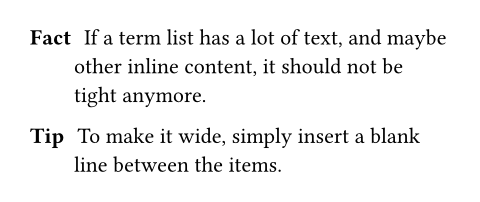termsElementElementElement functions can be customized with set and show rules.
set and show rules.A list of terms and their descriptions.
Displays a sequence of terms and their descriptions vertically. When the descriptions span over multiple lines, they use hanging indent to communicate the visual hierarchy.
Example
/ Ligature: A merged glyph.
/ Kerning: A spacing adjustment
between two adjacent letters.

Syntax
This function also has dedicated syntax: Starting a line with a slash, followed by a term, a colon and a description creates a term list item.
ParameterParameterParameters are input values for functions. Specify them in parentheses after the function name.
terms(,,,,,)->tightSettableSettableSettable parameters can be set using the set rule, changing the default value used thereafter.
tightset rule, changing the default value used thereafter.Defines the default spacing of the term list. If it is
false, the items are spaced apart with
paragraph spacing. If it is true, they use
paragraph leading instead. This makes the list more
compact, which can look better if the items are short.
In markup mode, the value of this parameter is determined based on
whether items are separated with a blank line. If items directly follow
each other, this is set to true; if items are separated by a blank
line, this is set to false. The markup-defined tightness cannot be
overridden with set rules.
Show example
/ Fact: If a term list has a lot
of text, and maybe other inline
content, it should not be tight
anymore.
/ Tip: To make it wide, simply
insert a blank line between the
items.

trueseparatorSettableSettableSettable parameters can be set using the set rule, changing the default value used thereafter.
separatorset rule, changing the default value used thereafter.The separator between the item and the description.
If you want to just separate them with a certain amount of space, use
h(2cm, weak: true) as the separator and replace 2cm with your
desired amount of space.
Show example
#set terms(separator: [: ])
/ Colon: A nice separator symbol.

h(amount: 0.6em, weak: true)indentSettableSettableSettable parameters can be set using the set rule, changing the default value used thereafter.
indentset rule, changing the default value used thereafter.The indentation of each item.
0pthanging-indentSettableSettableSettable parameters can be set using the set rule, changing the default value used thereafter.
hanging-indentset rule, changing the default value used thereafter.The hanging indent of the description.
This is in addition to the whole item's indent.
Show example
#set terms(hanging-indent: 0pt)
/ Term: This term list does not
make use of hanging indents.

2emautoThe term list's children.
When using the term list syntax, adjacent items are automatically collected into term lists, even through constructs like for loops.
Show example
#for (year, product) in (
"1978": "TeX",
"1984": "LaTeX",
"2019": "Typst",
) [/ #product: Born in #year.]

DefinitionsDefinitionsThese functions and types can have related definitions. To access a definition, specify the name of the function or type, followed by the definition name separated by a period.
itemElementElementElement functions can be customized with set and show rules.
itemset and show rules.A term list item.
termRequiredRequiredRequired parameters must be specified when calling the function.PositionalPositionalPositional parameters can be set by specifying them in order, omitting the parameter name.
termThe term described by the list item.
descriptionRequiredRequiredRequired parameters must be specified when calling the function.PositionalPositionalPositional parameters can be set by specifying them in order, omitting the parameter name.
descriptionThe description of the term.